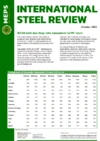Domestic oversupply persists in US rebar market
Reinforcing bar producers in the United States lowered their prices during May, despite imported material being largely absent from the market.
Insight published in the May edition of MEPS’s International Steel Review shows that the price range for domestic rebar decreased by around USD20 per short ton during the latest research period.
- MEPS International delivers monthly price data and commentary from the US steel market in its International Steel Review publication. Contact MEPS for details of the report and how to subscribe.
Domestic supply continues to outpace local demand, MEPS’s research respondents say. Consequently, steel manufacturers were willing to offer price concessions to plug gaps in their production schedules.
Owing to the onset of new capacity in recent years, rebar availability is plentiful in the US. Mill delivery lead times are extremely short and the majority of common sizes and specifications – for both rebar in coil and straight bar - can be sourced from mill stocks within days. Non-standard items are also readily available.
Purchasing managers can buy what they need to honour customer orders flexibly, and at short notice, and have little appetite to purchase material for stock. This is despite keeping their inventories at minimum levels to reduce their exposure to the downward price trend.
Borrowing costs stall residential construction
Demand from the construction industry remains mixed. Building activity – related to residential housing – is weaker than anticipated. The high cost of finance is having a negative impact on new home ownership.
Nevertheless, US rebar suppliers have some grounds for optimism from both a demand and supply standpoint.
Commercial construction activity is stable. There has been an increase in demand for material to construct data centres, and a relatively mild winter in most areas of the US helped to maintain activity levels in first quarter 2024.
An expected fall in the cost of borrowing later in the year could lead to an uptick in activity. In any case, many businesses should be able to plan ahead in the knowledge that the Federal Reserve is unlikely to raise interest rates any time soon.
Domestic buyers prefer to procure their needs from local sources. They claim that non-North American material holds little appeal. Market participants report a small gap between domestic and import prices, currently, and in some instances they are identical.
Importers deterred from US market
Global steel exporters traditionally view the US as an attractive proposition for selling their surplus material due to the relatively high prices commanded in the country.
Most European and Asian rebar producers are currently struggling to compete in the US market, however. Section 232 legislation is a significant barrier to entry. Countries who do not have tariff or quota exemptions have to contend with a 25% duty on steel products, as well as associated freight and port charges.
Consequently, exporters are likely to seek more financially viable opportunities in other parts of the world. US consumers, meanwhile, will be reluctant to commit to Q4/24 deals. This is because there is little to no price advantage.
According to recent ISSB statistics, US rebar imports fell by 20% year-on-year in the first three months of 2024. It is reported that Egypt (49,240 tonnes), Algeria (32,854 tonnes) and Turkey (32,566 tonnes) were the non-North American countries selling the largest volumes into the country.
Imported volumes are favoured more by steel buyers located in coastal regions of the US. Buyers in the Midwest region typically use imports to top up their requirements, or to maintain global relationships. MEPS respondents believe that the recent opening of the Great Lakes Seaway will do little to alter current trends.
The pricing ambitions of US rebar mills will be boosted by a lack of buying options, globally. Nevertheless, it may prove difficult to avoid the effect of further price erosion as the steel market heads into the traditionally slower summer months. May’s slight softening of shredded scrap costs, despite initial expectations of price stability, will do little to help their cause in the short term.

Source:
International Steel Review
The MEPS International Steel Review is an essential monthly publication, offering professional analysis and insight into carbon steel prices around the world.
Go to productRequest a free publication





